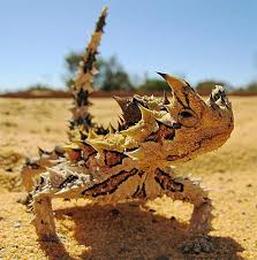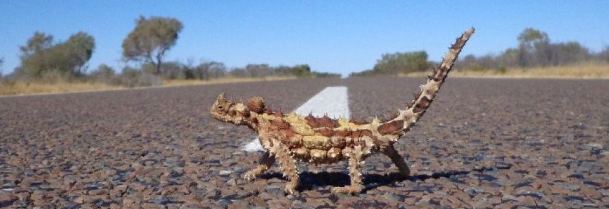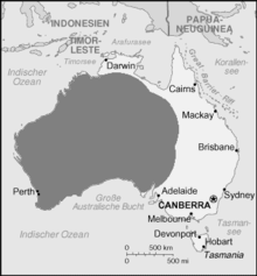Thorny DevilMoloch horridus |

Custom Search
|
Despite its name, the thorny devil does not exceed 20 cm in length. Females are somewhat larger than males. The color, which they can control, such as the Veiled Chameleon (
Chamaeleo calyptratus), ranging from tan, yellow to dark brown, depending on the type of soil, and serving as camouflage. Their colors change from paler shades during warm weather to darker colorations during the cold weather. It has a "false head" behind the real one, which it uses to confuse predators. It has conical spines all over the body except for the belly where they are replaced by lumps. Although his body covered with conical spines, their extreme slowness makes it an easy prey. Their predators are the great bustard, which makes fast descents on it, trying to stun and kill it. Goannas or monitor lizards like the Perentie (Varanus giganteus) which is the largest one native to Australia also prey on them. However, the thorny devil has some defense techniques like sticking his head between its front legs and show the "false head" for predators to take for real. If the predators try to roll to expose its belly, the area of his body most unprotected, the devil strikes back by putting pressure on the spines and the tail. To scare off predators can they also "swell" to give the impression of being much larger. The thorny devil reaches maturity at 3 years and is believed to live 20 years in the wild.

Thorny devils don’t like extreme temperatures either hot or cold, so they are almost completely inactive during the colder winter months or the hottest summer months and the
Usually, they will take refuge in underground burrows during these periods. They become active in the autumn (March, April, and May) and from the later winter through early summer, it's during this time they mate and lay eggs. Subspecies / Taxonomy There are no subspecies currently recognized for them. Their scientific name, Moloch horridus, was inspired by the poem “Paradise Lost" from John Milton. In it, the Canaanite god Moloch is described as a horrible king covered with the blood from human sacrifices. While the Latin word horridus translates to dreadful, rough or bristly. The Thorny Devil was first described in 1841 by the biologist John Edward Gray. It is the only species in the genus Moloch, but other species might remain undiscovered in the wild. They are distantly related and similar looking to the North American horned lizards of the genus Phrynosoma in an obvious example of convergent evolution. Diet / Feeding The thorny devil has ants as their only food, especially of the genus Iridomyrmex. The Thorny Devil is a “sit-and-wait” predator, they look for a feeding site near an ant trail and wait for them to pass near before eating them. They only eat one ant at a time, which it captures with its sticky tongue, but can eat them at a rate of 45 per minute. They can eat between 600 to 3000 in a single meal and more than 10,000 per day. They have specialized teeth to deal with the hard ant's bodies. To drink the thorny devil is able to condense the humidity of desert's cold nights on the scales and channel it to the mouth through existing grooves among the thorns. The same happens on rainy days or if he finds a puddle. Reproduction The reproduction cycle of the thorny devil isn't very well studied. There's some evidence that these lizards may travel relatively long distances to converge together at landmarks for mating. A few observations of their mating behavior suggests that males approach females bobbing their heads. Copulation takes place if the female is receptive otherwise the female falls and rolls to throw off the male showing that it is unreceptive. The thorny devil mating and egg laying season occur between September and January in late winter through early summer. The female lays between 10 to 30 eggs in shallow burrows excavated in southern facing sand ridges. After laying eggs the female fills in the burrow and smooths out the surface covering any evidence of its activity. The eggs hatch 3 to 4 months later, and apparently, the younglings eat their own egg casing before climbing out of their nest. The hatchlings weigh on average a mere 1.8 grams and measure 63 to 65 mm in length. Conservation status and main threats The thorny devil taxon has not yet been assessed for the IUCN Red List. The thorny devil population is currently not considered either endangered or threatened, and the species is protected under the Wildlife Conservation Act. But roadkill is a problem since they get mistaken for twigs and are often run over by cars in the Australian outback.
|
Scientific classification
Kingdom: Animalia Phylum: Chordata Class: Reptilia Order: Squamata Suborder: Iguania Family: Agamidae Subfamily: Amphibolurinae Genus: Moloch Species: M. horridus |


